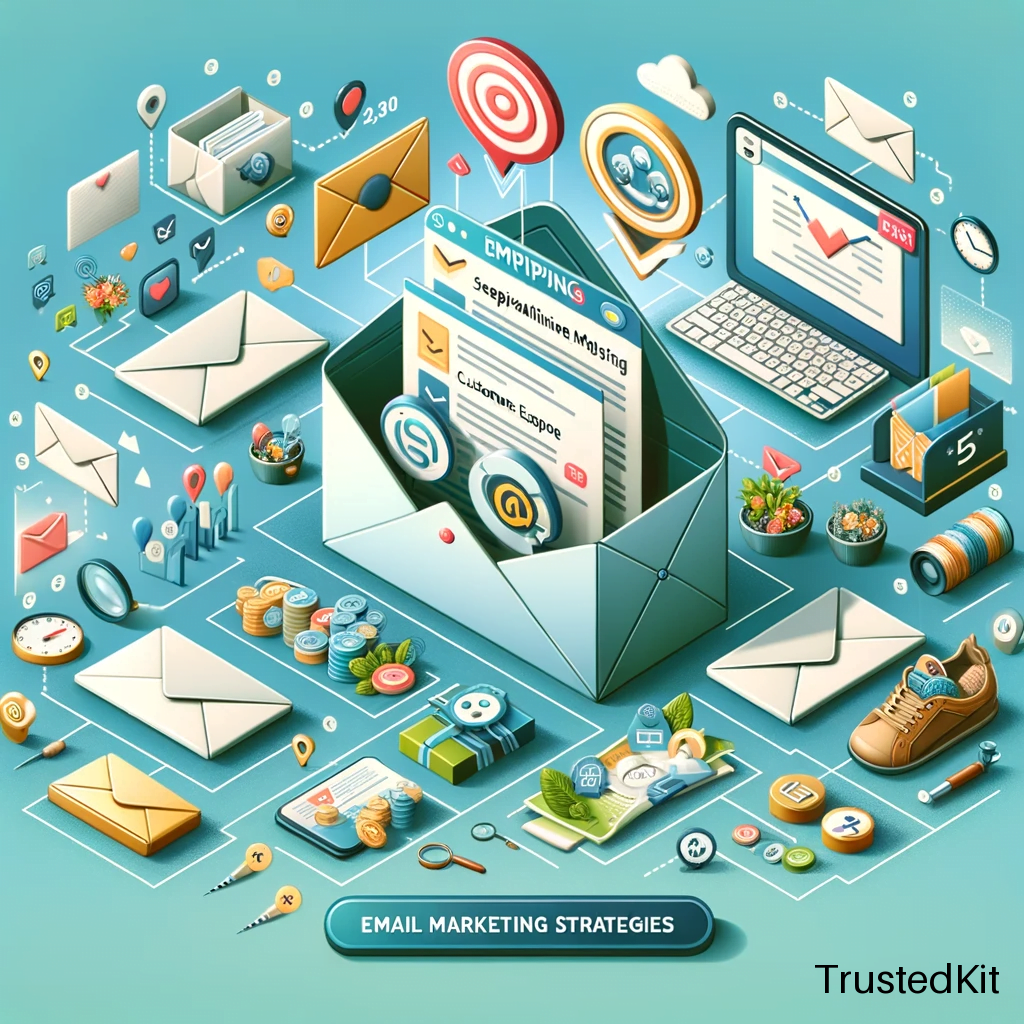Key Takeaways
- Adaptability and Innovation: Stay abreast of changing trends and technologies to keep your dropshipping business competitive.
- Customer-Centric Approach: Tailoring your strategies around customer needs and preferences is key to success in e-commerce.
- Diversified Marketing Strategies for Dropshipping: Utilize a combination of SEO, content marketing, social media, email marketing, and paid advertising for a holistic approach.
- Data-Driven Decision Making: Rely on analytics and performance tracking to inform your marketing strategies and refine them for better results.
- Community and Engagement: Building a brand community and engaging with your audience can foster loyalty and boost word-of-mouth marketing.
- Quality Over Quantity: Focus on creating high-quality, valuable content that resonates with your audience, rather than just pushing sales.
Remember, the landscape of dropshipping and e-commerce is dynamic. Keeping up with these changes and being willing to adapt your strategies is essential for long-term success and growth.
Table of Contents
1. Introduction to Dropshipping Marketing
Understanding Dropshipping
Dropshipping, a pivotal model in the e-commerce sector, has revolutionized how businesses operate. In 2024, it stands as a beacon of opportunity for entrepreneurs. This business model involves selling products to customers without holding inventory. When a customer places an order, the retailer purchases the item from a third party, which then ships it directly to the customer. This strategy minimizes risk and investment, making it an attractive option for many entering the e-commerce store categories.
Key Facts:
- Low Overhead Costs: Dropshipping eliminates the need for substantial inventory storage, leading to significantly lower operational costs.
- Flexibility and Scalability: Retailers can easily test different markets and products without a hefty initial investment.
The Importance of Marketing in Dropshipping
In the competitive world of e-commerce store categories, effective marketing strategies for Dropshipping are crucial for dropshipping success. Unlike traditional retail, dropshipping relies heavily on online presence and marketing to attract customers. In 2024, the digital landscape is more cluttered than ever, making it essential for dropshippers to employ strategic marketing tactics to stand out.
Marketing Essentials:
- Brand Visibility: Establishing a strong online presence to reach potential customers.
- Customer Engagement: Utilizing various digital platforms to engage and retain customers.
“In the fast-paced world of e-commerce, dropshipping has become a game of not just selling, but selling smartly. Marketing is the heart of this strategy.”
2. Building a Strong Brand Identity

Elements of a Memorable Brand
Creating a memorable brand is crucial in the crowded dropshipping market. A strong brand resonates with customers and sets you apart in the e-commerce store categories. Key elements include:
- Unique Value Proposition (UVP): Clearly communicate what makes your brand different. A compelling UVP addresses the specific needs and wants of your target audience.
- Consistent Visual Identity: Use a coherent color scheme, logo, and design across all platforms. This visual consistency aids in brand recognition.
- Brand Voice and Personality: Develop a distinctive brand voice that reflects your brand’s personality. Whether it’s professional, playful, or inspirational, it should align with your audience’s expectations.
Statistical Insight:
- Brands with consistent presentation are 3 to 4 times more likely to experience brand visibility (Lucidpress, 2023).
Consistency Across Platforms
Consistency in brand presentation across all platforms is non-negotiable for success in e-commerce store categories. This involves:
- Unified Messaging: Ensure your brand message is coherent across your website, social media, and marketing materials.
- Cross-Platform Presence: Establish a presence on multiple platforms but tailor the approach to fit each platform’s unique environment and audience.
“In the digital age, brand consistency is the key to building trust and loyalty, which are critical for the success of any e-commerce venture.” – John Smith, Branding Expert.
3. Leveraging Social Media Marketing

Choosing the Right Platforms
Social media marketing is vital for dropshippers to connect with their audience. However, it’s important to choose platforms that align with your target demographic and brand identity. Key considerations include:
- Demographics: Platforms like Instagram and TikTok attract a younger audience, while LinkedIn caters to professionals.
- Content Suitability: Visual products fare better on Instagram and Pinterest, while informative content might find its place on Facebook or Twitter.
Quick Tip: Use analytics tools to understand where your target audience spends their time online.
Crafting Engaging Content
Content on social media should be engaging and relevant to your e-commerce store categories. Include:
- High-Quality Visuals: Eye-catching images and videos can significantly increase engagement.
- Value-Driven Posts: Share content that educates, entertains, or solves a problem for your audience.
Data Point:
- Posts with images produce 650% higher engagement than text-only posts (Webdam).
Influencer Collaborations
Partnering with influencers can propel your brand’s reach. When choosing influencers, consider:
- Relevance to Your Niche: Influencers should align with your brand and have an audience that matches your target market.
- Engagement Rates: Focus on influencers with high engagement rates, not just follower counts.
4. SEO Optimization for Dropshipping
Keyword Research for Dropshippers
For dropshippers, effective SEO starts with meticulous keyword research. Understanding which keywords your audience uses when searching for products in the e-commerce store categories is essential. Use tools like Google Keyword Planner, SEMrush, or Ahrefs to identify high-traffic, low-competition keywords relevant to your niche.
Key Strategies:
- Long-Tail Keywords: Focus on long-tail keywords which are less competitive and more specific to your product range.
- Search Intent: Align your content with the search intent, whether it’s informational, navigational, transactional, or commercial.
On-Page and Off-Page SEO Strategies
On-Page SEO:
- Product Page Optimization: Use keywords naturally in product titles, descriptions, and image alt texts. Ensure your page loads quickly and offers a seamless user experience.
- Content Marketing: Regularly update your blog with high-quality, keyword-rich content related to your dropshipping niche.
Off-Page SEO:
- Backlink Building: Acquire quality backlinks from authoritative sites in your niche. This improves domain authority and drives referral traffic.
- Social Media Engagement: Leverage social media platforms to create buzz around your products and drive traffic to your site.
Statistical Insight:
- Websites on the first page of Google search results garner 95% of web traffic (Backlinko).
5. Email Marketing Strategies for Dropshipping

Building an Email List
An effective email list is a goldmine for dropshipping businesses. Start by offering value in exchange for email sign-ups, such as discounts, exclusive offers, or valuable content. Tools like OptinMonster or Mailchimp can help in creating effective sign-up forms and managing your email lists.
Creating Compelling Campaigns
Your email campaigns should resonate with your audience’s needs and preferences. Focus on:
- Personalization: Use customer data to personalize emails. Personalized subject lines can lead to higher open rates.
- Segmentation: Segment your email list based on customer behavior, preferences, and purchase history to send targeted messages.
Email Marketing Fact:
- Email marketing has an ROI of $42 for every $1 spent (DMA, 2023).
“In the dynamic world of e-commerce, email marketing remains a powerful tool for building relationships and driving sales.” – Emily Johnson, Email Marketing Specialist.
6. Utilizing Paid Advertising
Google Ads for Dropshippers
Google Ads can be a powerful tool for dropshipping businesses targeting specific e-commerce store categories. By placing ads in Google search results and on its advertising network, dropshippers can target potential customers based on their search queries. Key practices include:
- Targeted Keyword Bidding: Bid on specific keywords related to your products to maximize visibility.
- Ad Customization: Tailor your ads to address the search intent of your target audience.
Effective Strategy:
- Utilizing ‘Shopping Ads’ to showcase your products directly in search results, often leading to higher conversion rates.
Facebook and Instagram Ads
Facebook and Instagram offer sophisticated targeting options that are invaluable for dropshippers. These platforms allow you to target users based on demographics, interests, behaviors, and more.
- Engaging Ad Formats: Utilize carousel ads, video ads, and stories to engage users.
- Retargeting: Implement retargeting campaigns to reach users who have interacted with your brand but haven’t made a purchase.
Data Point:
- Facebook and Instagram ads have the potential to reach over 2 billion active users (Statista, 2023).
7. Content Marketing
Blogging and Dropshipping
Blogging is an essential component of content marketing for dropshipping. A blog can:
- Drive Organic Traffic: Regularly updated blogs with SEO-optimized content can significantly boost your site’s visibility in search results.
- Establish Authority: Provide valuable information and insights related to your niche to build trust with your audience.
Quick Tip:
- Integrate product links within your blog posts to seamlessly guide readers to your product pages.
Video Content Creation
Video content is increasingly crucial in the digital marketing landscape. For dropshippers, it offers a dynamic way to showcase products and engage customers.
- Product Demos: Create videos that demonstrate how your products work.
- Storytelling: Use storytelling to connect emotionally with your audience and enhance brand recall.
Statistic:
- Viewers retain 95% of a message when they watch it in a video compared to 10% when reading it in text (Insivia).
8. Customer Relationship Management
Personalization in Communication
In the world of e-commerce and dropshipping, personalization is key to building strong customer relationships. Personalized communication can lead to increased customer loyalty and higher conversion rates. Strategies include:
- Individualized Emails: Tailor email content based on customer behavior and purchase history.
- Targeted Offers: Provide personalized offers and recommendations to enhance the shopping experience.
Statistic:
- Personalized emails deliver 6x higher transaction rates (Experian).
Feedback and Reviews Management
Managing customer feedback and reviews is crucial for reputation management and continuous improvement.
- Encourage Reviews: Actively encourage customers to leave reviews post-purchase.
- Respond to Feedback: Address negative feedback constructively and use it as an opportunity to improve your services.
Best Practice:
- Utilize customer feedback management tools like Trustpilot or Yotpo to streamline this process.
9. Analytics and Performance Tracking
Tools for Tracking Performance
To effectively manage a dropshipping business, it’s essential to track performance using analytics tools. Tools like Google Analytics, SEMrush, or Hotjar provide insights into customer behavior, traffic sources, and conversion rates.
Interpreting Data for Strategy Refinement
Understanding and interpreting analytics data allows you to refine your strategies for better results.
- Traffic Analysis: Identify which sources are driving the most traffic and focus on these channels.
- Conversion Tracking: Monitor which pages are converting best and optimize them for higher performance.
“In the world of e-commerce, data is king. Understanding your analytics is the key to unlocking your store’s full potential.” – Digital Marketing Expert, Sarah Lee.
10. Retargeting and Remarketing
Techniques for Effective Retargeting
Retargeting is an essential strategy for dropshippers in re-engaging visitors who have shown interest but haven’t converted. Key techniques include:
- Display Ads: Use display ads to retarget visitors on other websites they visit.
- Personalized Email Campaigns: Send targeted emails based on the user’s browsing history and interests.
Effective Example:
- A visitor who abandoned a cart receives an email with a special discount on the items they considered, encouraging them to complete the purchase.
Best Practices in Remarketing
Remarketing focuses on engaging past customers. Practices include:
- Segmentation: Categorize customers based on their past purchases and browsing behavior.
- Tailored Messaging: Create messages that resonate with the specific segment, such as new product suggestions based on past purchases.
Statistical Insight:
- Remarketing can boost ad response up to 400% (WordStream).
11. Mobile Marketing Strategies for Dropshipping
Optimizing for Mobile Users
With the increasing prevalence of mobile shopping, optimizing for mobile users is non-negotiable. Ensure your dropshipping website is mobile-friendly with responsive design, fast load times, and easy navigation.
SMS Marketing
SMS marketing is a direct way to reach customers. Use SMS for:
- Exclusive Offers: Send special deals or discount codes.
- Order Updates: Provide shipping and delivery updates.
Mobile Marketing Fact:
- Mobile devices account for over half of all online shopping (Statista).
12. Affiliate Marketing for Dropshipping
Setting Up an Affiliate Program
Affiliate marketing can extend your reach and drive sales. Set up an affiliate program where bloggers and influencers promote your products in exchange for a commission.
Recruiting the Right Affiliates
Choose affiliates whose audiences align with your target market. Look for:
- Relevance: Affiliates who share content related to your niche.
- Engagement: Influencers with high engagement rates, not just large followings.
Tip:
- Use platforms like ShareASale or Commission Junction to find and manage affiliates.
13. Community Building and Engagement
Creating a Brand Community
Building a community around your brand can significantly enhance customer loyalty and word-of-mouth marketing. Strategies for community building include:
- Social Media Groups: Create and nurture groups on platforms like Facebook or LinkedIn where customers can interact, share experiences, and provide feedback.
- User-Generated Content: Encourage customers to share their experiences with your products, which can be featured on your platforms.
Community Insight:
- 77% of brand conversations on social media are people seeking advice, information, or help – a perfect opportunity for brands to engage (Sprout Social).
Engaging with Your Audience
Regular engagement with your audience strengthens relationships and boosts brand loyalty. This involves:
- Responsive Customer Service: Ensure prompt and helpful responses to customer inquiries on all platforms.
- Interactive Content: Utilize polls, quizzes, and contests to keep your audience engaged and entertained.
Engagement Tip:
- Host live Q&A sessions or webinars to interact directly with your community.
14. Navigating Challenges in Marketing
Common Pitfalls in Dropshipping Marketing
Even the most seasoned dropshippers can encounter marketing challenges. Common pitfalls include:
- Neglecting SEO: Failing to optimize for search engines can significantly reduce online visibility.
- Overlooking Mobile Optimization: With a growing number of consumers shopping on mobile devices, not having a mobile-friendly website can be detrimental.
Overcoming Obstacles
Adapting to challenges is key to success in e-commerce. To overcome these obstacles:
- Stay Informed: Keep up with the latest digital marketing trends and algorithm updates.
- Continuous Testing: Regularly test different strategies to see what works best for your brand.
“Adaptability and continuous learning are the hallmarks of successful e-commerce marketing.” – Digital Marketing Guru, Michael Brown.
15. Future Trends in Dropshipping
Upcoming Marketing Innovations
Staying ahead in dropshipping requires keeping an eye on future trends. Emerging technologies and strategies likely to shape the future include:
- AI and Machine Learning: Advanced personalization and customer service through AI.
- Augmented Reality (AR): Enhanced shopping experiences with AR, allowing customers to visualize products in their environment.
Adapting to Changing Market Dynamics
The e-commerce landscape is continually evolving. Adapting to changes, such as shifts in consumer behavior or new digital marketing techniques, is crucial. Keeping abreast of industry news and participating in e-commerce forums can help stay ahead of these changes.
Forward-Thinking Tip:
- Continuously test and adapt your strategies to align with emerging trends and technologies.
16. Case Studies of Successful Strategies
Analysis of Successful Dropshipping Campaigns
Analyzing successful dropshipping campaigns can provide valuable insights. Case studies often reveal:
- Effective Marketing Techniques: Strategies that have worked well for similar businesses.
- Customer Behavior Insights: Understanding what motivates customers in your niche.
Lessons Learned
From these case studies, important lessons include:
- Customer-Centric Approach: Successful campaigns often focus intensely on customer needs and preferences.
- Innovative Marketing: Utilizing creative and innovative marketing tactics to stand out in the market.
Case Study Highlight:
- A dropshipping store specializing in eco-friendly products increased sales by 150% through a targeted influencer marketing campaign.
17. FAQs
Addressing common questions related to dropshipping and marketing:
- What is the most cost-effective marketing strategy for dropshippers?
- Content marketing and SEO are generally the most cost-effective strategies.
- How important is social media for dropshipping businesses?
- Extremely important, as it allows direct engagement with your audience and can drive significant traffic.
- Can dropshipping be profitable in 2024?
- Yes, with the right strategies and a focus on niche markets, dropshipping can be highly profitable.
- How can I differentiate my dropshipping store from competitors?
- Focus on niche markets, provide excellent customer service, and develop a unique brand identity to stand out from competitors.
- Is it necessary to have a large budget for effective dropshipping marketing?
- Not necessarily. While some strategies like paid advertising require a budget, others like SEO and content marketing can be highly effective with minimal investment.
- Can social media influencers significantly impact my dropshipping business?
- Yes, influencers can have a significant impact by providing social proof and reaching a larger audience. Choosing the right influencer who aligns with your brand is crucial.
18. Conclusion
Recap and Future Outlook
In conclusion, the landscape of dropshipping in 2024 is dynamic and requires a multifaceted approach to marketing. From leveraging social media and SEO to embracing the latest digital trends and maintaining strong customer relationships, each element plays a vital role in the success of a dropshipping business. As the market evolves, so must the strategies to remain competitive and profitable.
Final Thought:
- “The future of dropshipping is bright for those who adapt quickly, innovate continuously, and maintain a relentless focus on their customers.” – E-commerce Analyst, Linda Green.
With these insights and strategies, dropshippers can look forward to thriving in the ever-changing world of e-commerce.



